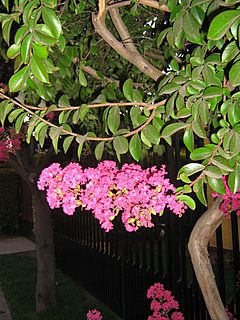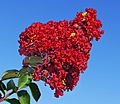Crepe myrtle facts for kids
Quick facts for kids Crepe myrtle |
|
|---|---|
 |
|
| Lagerstroemia indica | |
| Scientific classification | |
| Kingdom: | |
| Division: | |
| Class: | |
| Order: | |
| Family: | |
| Genus: |
Lagerstroemia
|
| Species | |
|
See text |
|
Lagerstroemia (properly Crape-myrtle, sometimes spelled Crepe-myrtle) is a genus of around 50 species of deciduous and evergreen trees and shrubs native to the Indian subcontinent, southeast Asia, northern Australia and parts of Oceania. It is a member of the Lythraceae, which is also known as the Loosestrife family.
Description
While various species and cultivars are able to fill a wide variety of landscape needs, crape-myrtles are chiefly famous for their colorful and long-lasting flowers. Most species of Lagerstroemia have sinewy, fluted stems and branches with a mottled appearance that arises from having bark that sheds throughout the year. The leaves are opposite, simple, with entire margins, and vary from 5-20 cm (2-8 in). While all species are woody in nature, they can range in height from over 100 feet to under one foot; most, however are small to medium multiple-trunked trees and shrubs. The leaves of temperate species provide autumn colour.
Flowers are borne in summer and autumn in panicles of crinkled flowers with a crepe-like texture. Colours vary from deep purple to red to white, with almost every shade in between. Although no blue-flowered varieties exist, it is toward the blue end of the spectrum that the flowers trend, with no sight of orange or yellow except in stamens and pistils. The fruit is a capsule, green and succulent at first, then ripening to dark brown or black dryness. It splits along six or seven lines and releases numerous small winged seeds.
The leaves of L. parviflora are fed on by the Antheraea paphia moth which produces the tassar silk, a form of wild silk of commercial importance in India.
Landscaping and gardening
Certain species of crepe myrtle are used in landscaping and gardening as screens, lawn specimens, shrub borders, and container plants. The common crepe myrtle from China and Korea was introduced in 1790 to Charleston, South Carolina, in the United States by the French botanist André Michaux.
In the wild, the species is most often found as a multi-stemmed large shrub, but 200 years of cultivation have resulted in a huge number of cultivars of widely varying characteristics. Today, crepe myrtle varieties can fill every landscape need, from tidy street trees to dense barrier hedges to fast-growing dwarf types.
Images for kids
-
A 4 m (12 ft) crape myrtle in Lutherville, Maryland
See also
 In Spanish: Lagerstroemia para niños
In Spanish: Lagerstroemia para niños








